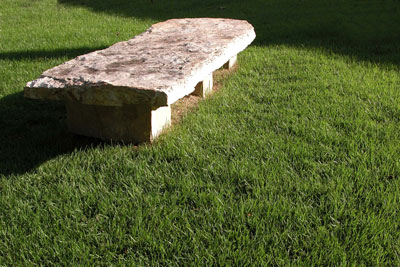Steps to Thicker Turf
In spite of what some may argue, Texans do care about their lawns. It’s just that the results aren’t always stunning. Here are steps I offer to get a better outcome:
• Start with the best grass for the task. Just for examples, bermuda handles traffic better than others. St. Augustine is more tolerant of shade. Zoysias are coming up in popularity and do deserve consideration, but not from those crazy mailorder sources you still see now and then. I can’t recommend buffalograss for most situations because of the invasive nature of bermuda. It will almost always completely overtake the buffalo grass within just a few years. Fescue may work for folks in the Panhandle and South Plains.

Zoysia is beautiful in this Hill Country landscape.
• Be sure you have enough sunlight. Optimum amounts: buffalograss – full or almost full sun; bermuda – 8 hours or more; zoysias – 6 or 7 hours or more; St. Augustine 5 or 6 hours or more; tall fescue 5 or 6 hours or more, but only adapted in North and Northwest Texas.
• Mow at the correct heights. Buffalograss should be cut at 3-1/2 to 4 inches. Fescue at 3 to 3-1/2. St. Augustine at 2 to 2-1/2. Zoysias at 1-1/2 to 2 inches, depending on the variety. Common bermuda at 1-1/4 to 1-1/2 inch and dwarf hybrid bermudas at 1/4- to 3/4-inch, depending on the variety. Mowing higher than the recommended height encourages the grass to grow tall and spindly, therefore weak. Mow often (preferably on 5-day intervals) in late spring and summer when the grass is growing at full pace.

Proper watering is a key to success.
• Water deeply, then wait until ground begins to dry out before you water again. That will encourage deeper root growth. A “smart” controller will determine how often that will need to be at various seasons.
• Use all-nitrogen fertilizers, preferably one containing half of that nitrogen in encapsulated or coated, timed-release form for sustained feeding. Inexpensive, fast-release types of nitrogen lead to thatch build-ups and disease.
• Learn to recognize early symptoms of lawn problems, then step to your plants’ aid as soon as you see any symptoms.
2018 was a very challenging year for many Texas lawnkeepers. Let’s hope that this will be a more normal season for us all. Go into it prepared for the worst and hope you’ll be surprised!
